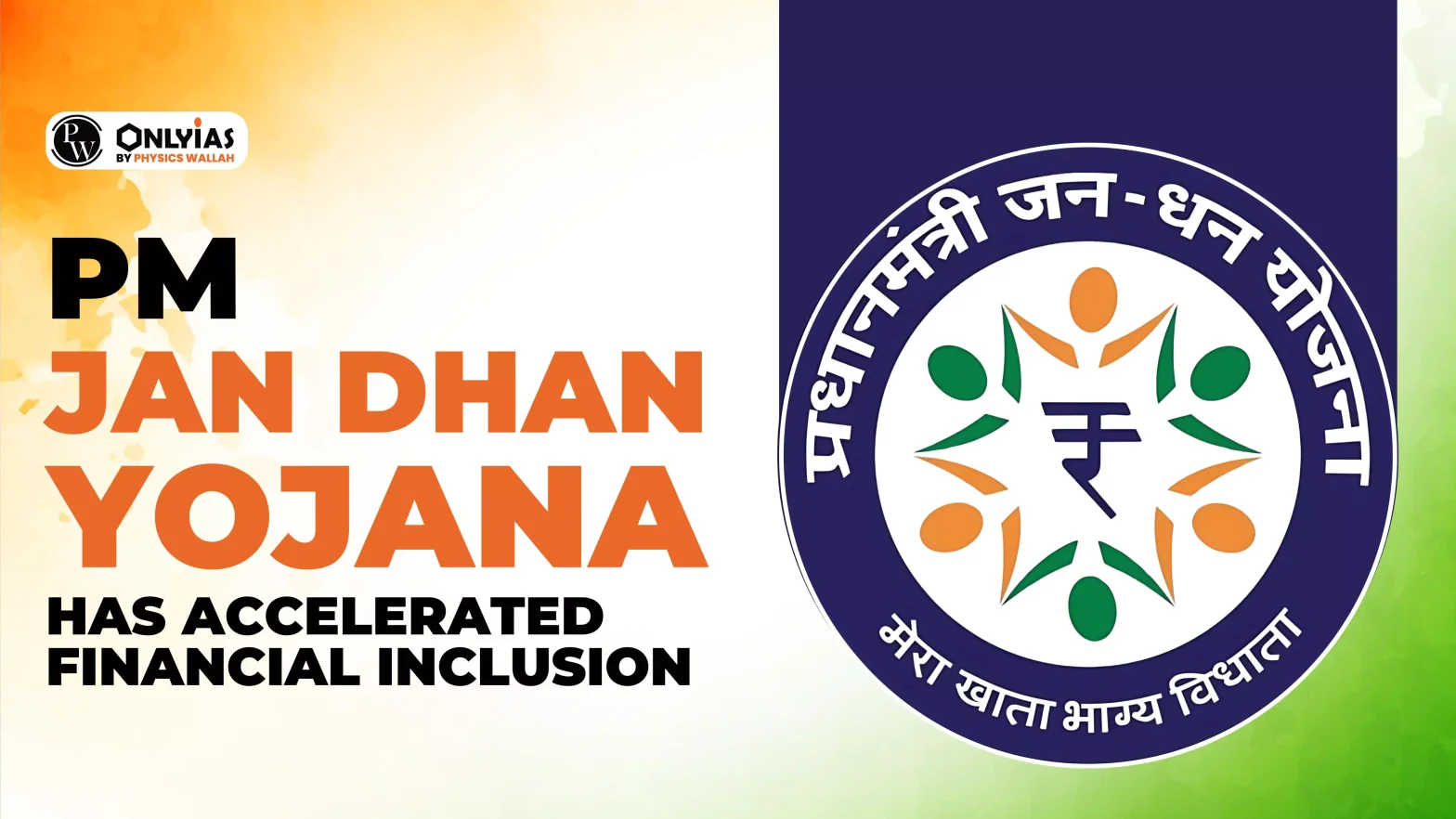The Pradhan Mantri Jan Dhan Yojana (PMJDY), launched on August 28, 2014, marked a significant step toward inclusive growth by aiming to provide banking facilities to every unbanked household. As the scheme completes 10 years, its impact on financial inclusion in India is evident.
Financial Inclusion
- Financial inclusion refers to making financial services—such as bank accounts, insurance, and loans—accessible, affordable, and usable for all individuals.
- Greater financial inclusion reduces inequalities by allowing the poor to access credit, start businesses, and secure insurance during times of need, thereby preventing them from falling below the poverty line. Thus, it is essential for economic security and stability.
Enroll now for UPSC Online Course
PM Jan Dhan Yojana and Financial Inclusion
Pradhan Mantri Jan-Dhan Yojana (PMJDY) is a National Mission for Financial Inclusion aimed at ensuring access to financial services such as basic savings and deposit accounts, remittance, credit, insurance, and pension in an affordable manner. Under the scheme, a basic savings bank deposit (BSBD) account can be opened in any bank branch or Business Correspondent (Bank Mitra) outlet by persons who do not have any other account.
- Key Benefits of PMJDY: It provided opening of a basic savings bank account with no minimum balance requirement, earning interest on deposits, and receiving a RuPay Debit card. Additionally, account holders benefit from accident insurance cover. Eligible account holders can also access an overdraft facility of up to Rs. 10,000. Furthermore, PMJDY accounts qualify for various other schemes such as Direct Benefit Transfer (DBT), Pradhan Mantri Jeevan Jyoti Bima Yojana (PMJJBY), Pradhan Mantri Suraksha Bima Yojana (PMSBY), Atal Pension Yojana (APY), and the Micro Units Development & Refinance Agency Bank (MUDRA) scheme.
- Target of the scheme: At the time of its launch, the government aimed to bring 7.5 crore unbanked households under the banking system. This initiative was implemented in two phases: Phase I and Phase II.
- JAM Trinity: Another critical feature of the scheme was leveraging the JAM (Jan Dhan-Aadhaar-Mobile) trinity. This initiative aimed to integrate millions into the formal financial system, driving economic empowerment at the grassroots level. By linking bank accounts (Jan Dhan), biometric identification (Aadhaar), and mobile connectivity (Mobile), the scheme significantly enhanced the efficiency of financial services and facilitated greater financial inclusion in India.
- UPI: The effectiveness of this system is evident in the seamless and efficient payments facilitated by UPI (Unified Payments Interface), a system that has achieved a level of efficiency not seen in many developed countries.
Impact of PMJDY on Financial Inclusion
- Increase in Financial Account Ownership: Since its inception, PMJDY has significantly boosted financial inclusion in India. The proportion of adults with formal financial accounts has risen from around 50% in 2011 to over 80% today.
- Role of Public Sector Banks: Public sector banks have played a crucial role, contributing to 78% of the 53 crore PMJDY accounts, with a total balance of Rs 2.31 lakh crore as of August 2024. While public sector banks have been instrumental, involving private banks could further enhance efficiency.
- Reduction in Gender Gap: PMJDY data reveals that 81.2 percent of the accounts are operative. Additionally, 55.6 percent of these accounts are held by women, and 66.6 percent are located in rural and semi-urban areas, demonstrating the scheme’s broad reach and impact.
- Impact in Backward Regions: States like Uttar Pradesh (with 9.4 crore accounts) and Bihar (6 crore accounts) have seen substantial participation, reflecting how traditionally backward regions can develop through initiatives like Jan Dhan accounts.
Check Out UPSC NCERT Textbooks From PW Store
Benefits of Jan Dhan Accounts
- Social Dimensions
- Reduction in Consumption of Intoxicants: There has been a statistically significant reduction in the consumption of intoxicants such as alcohol and tobacco in states with higher PMJDY account penetration. Earlier, people who did not save in banks found it easier to spend money on such items, but with money in the bank, the temptation to spend has reduced.
- Decreased Theft Rates: Research indicates a lagged reduction in thefts in states like Uttar Pradesh, Maharashtra, and Haryana due to increased usage of PMJDY accounts. States like West Bengal, Tamil Nadu, and Kerala have experienced ongoing positive impacts.
- Economic Implications:
- Growth of digital transactions: India recorded 55.7 billion UPI transactions by July 2024. This has contributed to the digitalization of the economy, promoting e-commerce and modern payment systems.
- Subsidy Streamline: The integration of PMJDY with Direct Benefit Transfer (DBT) has streamlined the distribution of government subsidies, plugging leakages, and reducing corruption. Over the last decade, Rs 38.49 lakh crore has been transferred via DBT, saving Rs 3.48 lakh crore in leakages.
Way Forward
Despite its successes, several barriers to financial inclusion remain. A multi-faceted approach is necessary to address these:
- Strengthening the Financial Ecosystem:
- Private Sector Involvement: There is a need to promote private-sector participation in financial inclusion through partnerships to ensure better growth.
- Financial Literacy and Capacity Building: Enhancing the financial literacy of individuals and small enterprises is crucial. Programs of financial literacy should be implemented to help people understand the benefits and usage of financial services.
- Gender-Inclusive Services: There should be a focus on promoting gender-inclusive financial services and programs.
- Expanding Financial Services Penetration
- Micro-insurance and Credit: Increase the availability of micro-insurance and credit, while ensuring that over-indebtedness is avoided.
- Enhancing Consumer Protection
- Trust in Digital Products: Digital products are complex and difficult for new users to understand. Therefore, consumer protection frameworks should be strengthened to maintain trust in these products.
- Customer-Centric Product Design:
- Lifecycle Needs: Financial products should be designed to meet the lifecycle needs of PMJDY account holders, many of whom have irregular incomes and unique financial requirements.
Enroll now for UPSC Online Classes
Conclusion
The PMJDY has significantly accelerated financial inclusion in India, reducing inequalities and promoting economic empowerment. The government has invested significant effort in bringing new users into the banking system through Jan Dhan accounts. Now, maintaining and further pushing these efforts will require equal commitment from the government, as it is responsible for ensuring that these new account holders can access and benefit from financial services. Challenges like cyber security, connectivity in rural areas, and ATM shortages must be addressed to make the scheme more efficient. Moving forward, it is crucial for future government programs to explore interlinking PMJDY accounts with other welfare schemes to ensure a holistic and sustainable approach to economic empowerment at the bottom of the pyramid.
![]() 2 Sep 2024
2 Sep 2024

